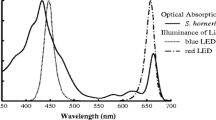Abstract
After a pre-treatment with red light, hair formation at the growing tip of the siphonaceous green alga Acetabularia mediterranea Lamour. (= A. acetabulum (L.) Silva) can be induced by a pulse of blue light. Red light is needed again after the inductive blue-light pulse if the new whorl of hairs is to develop within the next 24 h. In order to investigate the role of this red light, the duration of the red irradiation was varied and combined with periods of darkness. The response of hair-whorl formation was dependent on the total amount of red light, regardless of whether the red irradiation followed the blue pulse immediately or was separated from it by a period of darkness. Furthermore, periods of exposure to the photosynthesis inhibitor 3-(3′,4′-dichlorophenyl)-1-1dimethylurea had a similar effect to darkness. Both observations indicate that this red irradiation acts as a light source for photosynthesis. Whether or not the red light had an additional effect via phytochrome was tested in another type of experiment. The dependence of hair-whorl formation on red-light irradiance in the presence of simultaneous far-red irradiation was determined for the pre-irradiation period as well as for the irradiation period after the blue pulse. In both experiments, far-red light caused a small promotion of hair-whorl formation when low irradiances of red light were used. However, these differences were attributable to a low level of photosynthetic activity (which in fact was measurable) caused by red light reflected in the growth chamber. Furthermore, lowering the proportion of active phytochrome by far-red light would be expected to suppress hair-whorl formation. The influence of far-red light was also tested in a strain of Acetabularia mediterranea that developed hair whorls in about 20% of cells even when kept in complete darkness after the blue-light pulse. Far-red irradiation had no effect. These results strongly indicate that phytochrome is not involved in hair-whorl formation. Rather it is concluded that the effects of red light are caused by photosynthesis.
Similar content being viewed by others
Abbreviations
- DCMU:
-
3-(3′,4′-dichlorophenyl)-1,1-dimethylurea
References
Clauss, H. (1968) Beeinflussung der Morphogenese, Substanzproduktion und Proteinzunahme von Acetabularia mediterranen durch sichtbare Strahlung. Protoplasma 65, 49–80
Gibor, A. (1977) Cell elongation in Acetabularia. In: Progress in Acetabularia research, pp. 231–240, Woodcock, C.L.F., ed. Academic Press, New York
Hartmann, K.M. (1967) Phytochrome 730 (Pfr) the effector of the “high energy photomorphogenetic reaction” in the far red region. Naturwissenschaften 54, 544
Mohr, H. (1966) Untersuchungen zur phytochrominduzierten Photomorphogenese des Senfkeimlings (Sinapis alba L.). Z. Pflanzenphysiol. 54, 63–83
Schmid, R., Idziak, E.-M., Tünnermann, M. (1987) Action spectrum for the blue-light-dependent morphogenesis of hair whorls in Acetabularia mediterranea. Planta 171, 96–103
Schmid, R., Tünnermann, M., Idziak, E.-M. (1988) Transient reduction of responsiveness of blue-light-mediated hair-whorl morphogenesis in Acetabularia mediterranea induced by blue light. Planta 174, 373–379
Terborgh, J.W., Thimann, K.V. (1965) The control of development in Acetabularia crenulata by light. Planta 64, 241–253
Author information
Authors and Affiliations
Rights and permissions
About this article
Cite this article
Schmid, R., Tünnermann, M. & Idziak, EM. Role of red light in hair-whorl formation induced by blue light in Acetabularia mediterranea . Planta 181, 144–147 (1990). https://doi.org/10.1007/BF00202337
Received:
Accepted:
Issue Date:
DOI: https://doi.org/10.1007/BF00202337




